
The city of Cleveland will pay $6 million to the family of Tamir Rice, a 12-year-old boy fatally shot by police in 2014, based on a settlement agreement that allows the city to avoid a high-profile federal civil rights trial.
Lawyers for Rice’s family said Monday that “no amount of money can adequately compensate” for the boy’s loss.
“In a situation like this, there’s no such thing as closure or justice,” attorneys Jonathan S. Abady and Earl S. Ward in a said statement, according to the New York Times. “Nothing will bring Tamir back. His unnecessary and premature death leaves a gaping hole for those who knew and loved him that can never be filled.”
The agreement, which must still be approved by a probate court, was announced early Monday. The city of Cleveland – including officers and police dispatchers involved in the incident – does not admit any wrongdoing based on the terms of the settlement, according to reports.
Last year, a Cuyahoga County grand jury decided against indicting Cleveland Police Officer Timothy Loehmann, who fired at Rice on November 22, 2014, outside a city recreation center. A 911 call to police had reported a male holding a gun that was “probably fake.”This information was not passed on to police sent to the scene.
Rice had an Airsoft replica that lacked an orange safety feature that would have indicated it was not real. Loehmann shot at Rice almost immediately after exiting his squad car, claiming Rice had reached for his waistband. Rice, shot once in the torso, was not offered first aid by the officers and died the following day.
The settlement, revealed in a court filing from US District Judge Dan Polster, calls for a total of $5.5 million to go to Tamir Rice’s estate, with Tamir’s mother, Samaria Rice, and sister, Tajai Rice, to receive $250,000 each. Tajai Rice, 15, was with Tamir at the Cudell Recreation Center the day her brother was killed. Surveillance footage of the shooting shows her running to be near her brother once he was shot. Officer Frank Garmback, Loehmann’s partner, stopped her and forced her to the ground. The officers handcuffed her and put her in the back of their squad car as her brother lay dying mere feet away.
The city will pay $3 million this year and $3 million in 2017. The Rice family agreed in March to enter settlement talks with Cleveland. The city of Cleveland has not commented on the settlement, according to Cleveland.com.
Cuyahoga County Prosecutor Timothy J. McGinty has come under much scrutiny for his handling of Rice’s killing. Prior to the grand jury proceedings, McGinty hired two police use-of-force experts to write reports on Rice’s killing. Both reportsfound police acted reasonably during the encounter. McGinty’s office also asked several experts to officially comment on the legality of the shooting; they all said the officer used justifiable force in shooting Rice.
The Rice family has accused McGinty of soliciting expert reports to “make opinion early to soften the blow” ahead of a grand jury decision exonerating the officers involved, while McGinty has openly questioned the motives of the Rice family’s attorneys.
Two independent experts have countered, saying the shooting was unjustified. “The officers engaged in reckless tactical decision making, they unreasonably placed themselves in harm’s way, and Officer Loehmann’s use of deadly force was excessive, objectively unreasonable and inconsistent with generally accepted police practices,” wrote Jeffrey J. Noble, a former deputy police chief in Irvine, California.
In late December 2015, following a recommendation from Prosecutor McGinty, a grand jury decided against indicting Loehmann, saying the officer had a “mistaken, yet reasonable belief” he would be shot when Rice pulled the replica gun from his waistband.
Upon the decision, McGinty called the shooting a “perfect storm of human error, mistakes and miscommunications” but said that the evidence did not point to criminal misconduct by police.
Rice’s death came only two days after a grand jury in St. Louis County decided not to indict Darren Wilson, a former officer with the Ferguson Police Department in Missouri, over an August 2014 incident in which Wilson fatally shot unarmed black teenager Michael Brown. The fatal police shootings of both Rice and Brown, as well as many other people of color in the US, have triggered mass demonstrations against racial profiling, police brutality, police impunity, and the overall police-court-prison system in America.
The US Department of Justice is reviewing Rice’s shooting to surmise whether officers committed federal civil rights violations. Yet, to prove such violations occurred is not easy. To successfully bring federal civil rights charges, a US prosecutor must prove an officer was not negligent or reckless but that he or she “willfully” deprived someone of their rights.
A March analysis by the Pittsburgh Tribune-Review found that, from 1995 to 2015, federal prosecutors chose not to levy charges against US law enforcement officers alleged to have committed civil rights violations in 96 percent of relevant cases.
The settlement comes as the latest in a string of agreements between major US police departments and loved ones of fatally shot individuals killed by police in efforts to avoid a public court case following a wrongful-death lawsuit.
Last year, Baltimore agreed to pay $6.4 million to the family of Freddie Gray, who died inside a police van. In July, the family of Eric Garner, who died after he was put in a chokehold by New York City police for selling individual cigarettes on the street, was paid $5.9 million. The family of Walter Scott, fatally shot in the back by a South Carolina officer amid a traffic stop, settled with North Charleston for $6.5 million in October.
By Gordon Duff, Senior Editor
From July 15, 2015 with RT report to follow
As with the Charlie Hebdo farce in Paris last summer, the Tamir Rice killing in Cleveland, November 2014 doesn’t stand up under any analysis. With Hebdo, we expected dozens of YouTube gun junkies to head for the scrapyard and start pulverizing concrete sidewalk chunks with their AK’s. Never happened, not sure why. Nobody ever takes the “low hanging fruit” when it comes to debunking phony terror attacks or street theatre.
Let’s go after the Tamir shooting and put it to rest quickly. The video above is both purposefully “compressed” to reduce frame rate and has the resolution reduced as well, almost identical to the parking lot 9/11 video at the Pentagon showing a Tomahawk cruise missile slamming into the headquarters of the DOD.
“Dazzle em with Bullshit”
First thing to put to bed is the issue of the gun. From the video, you can see that less than 2 seconds elapsed from the time the car stopped to the shooting. In this time, police open the door, draw guns, identify the threat and react while, according to police testimony, shouting out three warnings. We have reason to believe that Tamir was holding an airsoft pistol. First, let’s differentiate between a “pellet gun” and an airsoft pistol. Be advised that airsoft pistols are extremely common and when a kid is in a park running around with a toy gun, it is usually a nearly totally harmless airsoft gun that is not really able to put your eye out. This is the ammo, actually “prills” as opposed to “pellets.”
On the other hand, this is a “pellet:”
 Do you think the failure to differentiate between the two is an accident? Pellets kill small game, stupid kids shoot each other with airsoft for amusement when parents aren’t watching.
Do you think the failure to differentiate between the two is an accident? Pellets kill small game, stupid kids shoot each other with airsoft for amusement when parents aren’t watching.
We are also told that Tamir had “modified” his airsoft pistol, actually belonging to another child we are told, by removing the orange barrel marker. Here is a common airsoft pistol from Walmart.
Did the officer in the video make any attempt to recognize the type of toy the child was carrying? Take a careful look at the toy above. It is reasonable to assume that the issue of “orange marker” or not are placed before us in hopes we don’t actually look at the video and learn about how some airsoft weapons are identified.
This is a common airsoft rifle:
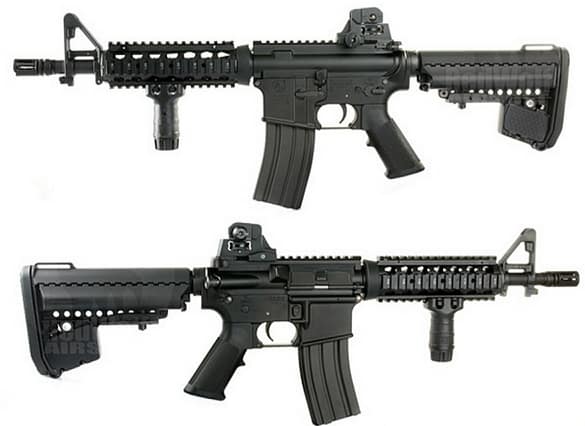 40% of the parts are interchangeable with a US military issue M4 carbine. The stock and rear sight on this are, in actuality, far better quality than US military issue.
40% of the parts are interchangeable with a US military issue M4 carbine. The stock and rear sight on this are, in actuality, far better quality than US military issue.
So, thus far, we have police barreling in, but wait, let’s talk about that.
If police approach a potential armed suspect, it is an established procedure to stop the car more than 35 yards away in order to take advantage of body armor, the protection of a vehicle to shield from bullets and the possibility that trained police officers might be better armed and better trained. As we see in the video, better armed for sure, as they were not carrying toy guns.
If this were a real gun and Tamir were older, he could legally “open carry” without a concealed weapons permit as allowed by Ohio law. Were he to draw the weapon in the presence of someone else without reason, he could be charged with disorderly conduct. Were he legally carrying a concealed weapon and drew it for no reason, he would be guilty of misdemeanor “brandishing” according to Ohio law.
Typical punishment were Tamir waving a real gun around would have been a stern warning from a judge.
Then again, the police never checked to see if Tamir was alone. If he did have friends and they did have real guns. the police would have been killed in seconds like happened in Brooklyn. Did they fail to check because they weren’t concerned, real guns, other shooters, “pedestrians?”
Is it a supportable hypothesis that the approach seen in the video would and could only be used for shooting a lonely kid with a toy gun who was a threat to no one at all? We will make that case, successfully I believe. See if you agree.
A trained police officer gains control of the situation by calmly addressing the “potential suspect” and asking them to drop what they are carrying in their hands and lay on the ground with their hands at their side. In most such cases, that process takes between 5 and 10 minutes. People stopped in public who are acting “unusual” are usually mental patients, disgruntled veterans, on drugs or alcohol or any or all of the above.
An officer who has acted properly is at minimal risk and has time to ascertain and control the situation, taking into account reality and television differ most of the time.
The only possible reason to act otherwise would be if the officer had forgotten all training and believed he was in a poorly written TV police drama. This seems to be the case.
There are some other issues as well. Supposedly we had numerous calls including one where someone said a woman had a gun stuck in her face. Toward that end, we have video showing a toy gun being pointed. Here is a frame depicting “a woman having a gun pointed in her face.”
 Now, lets take a look at where the toy gun is actually being pointed.
Now, lets take a look at where the toy gun is actually being pointed.
 First, I would have you note that the position of the alleged “toy gun pointer” shows that if someone were there on a cold November day, they might likely be as far as 200 meters away. We are going to go over this issue and others. Suffice it to say, this is perhaps your first view of the actual scene.
First, I would have you note that the position of the alleged “toy gun pointer” shows that if someone were there on a cold November day, they might likely be as far as 200 meters away. We are going to go over this issue and others. Suffice it to say, this is perhaps your first view of the actual scene.
We will examine more issues, including possible witness point of vision and foot traffic patterns through what you will clearly note, is the “middle of friggin’ nowhere.”
Let’s see where the witnesses were who called in. There is virtually NO foot traffic in this area and where Tamir was playing is not visible from sidewalks.
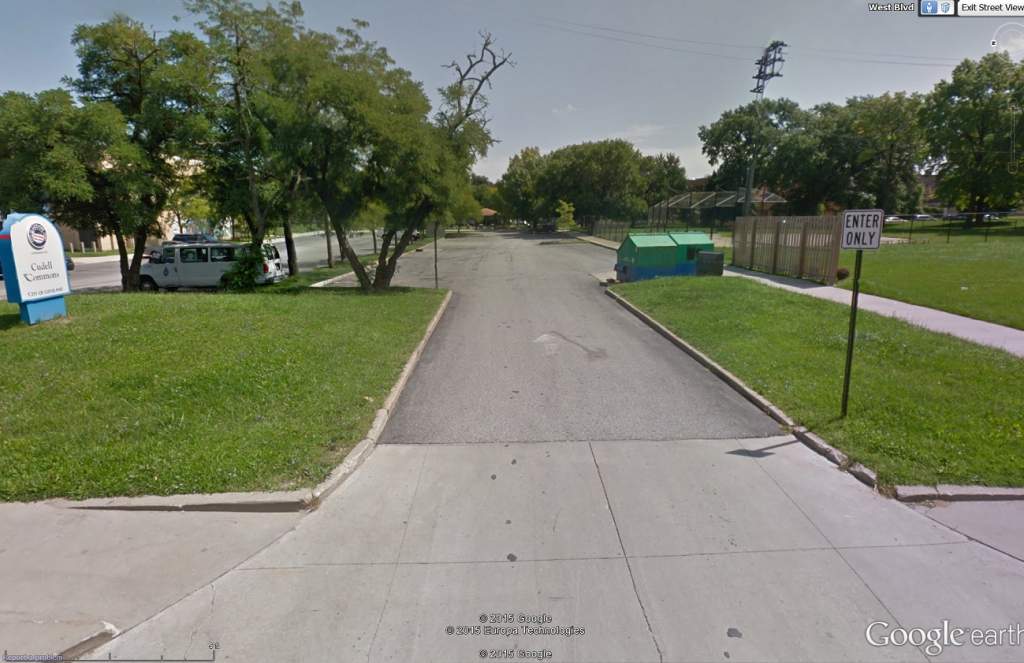
This is the closest sidewalk to where Tamir was shot, taken in the middle of a summer day. It would nearly be impossible to tell an elephant from a rabbit even in full light, based on cover and distance. Look for Tamir in the photo? See a gun? He’s not there but he could be, if he weren’t dead already. Nobody could tell, and this is the closest viewpoint. Were are going to take a look at this from above and identify how there could be a witness, perhaps one with a Hubble quality telescope:
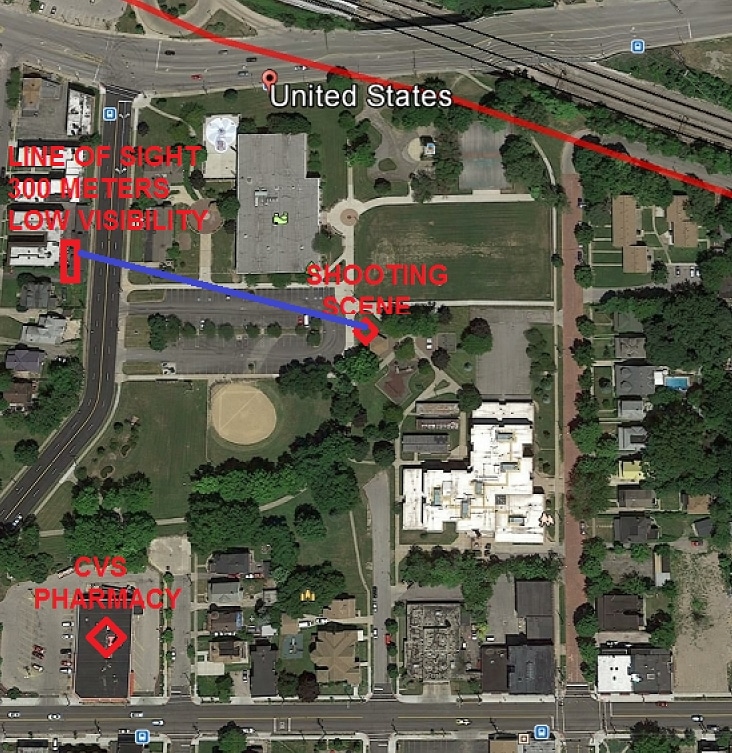 Here we identify several issues. Let’s think about people who would be walking past Tamir. As you can see, no one lives between Tamir and the CVS Pharmacy where lotto tickets, beer and cigarettes can be purchased. Examining patterns of home and automobile ownership, demographic patterns, for the two adjacent streets makes for an extremely low possibility anyone walked near Tamir. There is no place to go.
Here we identify several issues. Let’s think about people who would be walking past Tamir. As you can see, no one lives between Tamir and the CVS Pharmacy where lotto tickets, beer and cigarettes can be purchased. Examining patterns of home and automobile ownership, demographic patterns, for the two adjacent streets makes for an extremely low possibility anyone walked near Tamir. There is no place to go.
Here is a street scene from the opposite side. These are the homes and cars of people who drive to real places for the things they need, not people who shamble down to the corner for “cigs and malt liquor” before sleeping it off behind the school.
Line of sight from this side provides no visibility, even if the gazebo didn’t obscure vision:
We will take a look at the retail to the right of the CVS Pharmacy, the only potential place a pedestrian could be going.
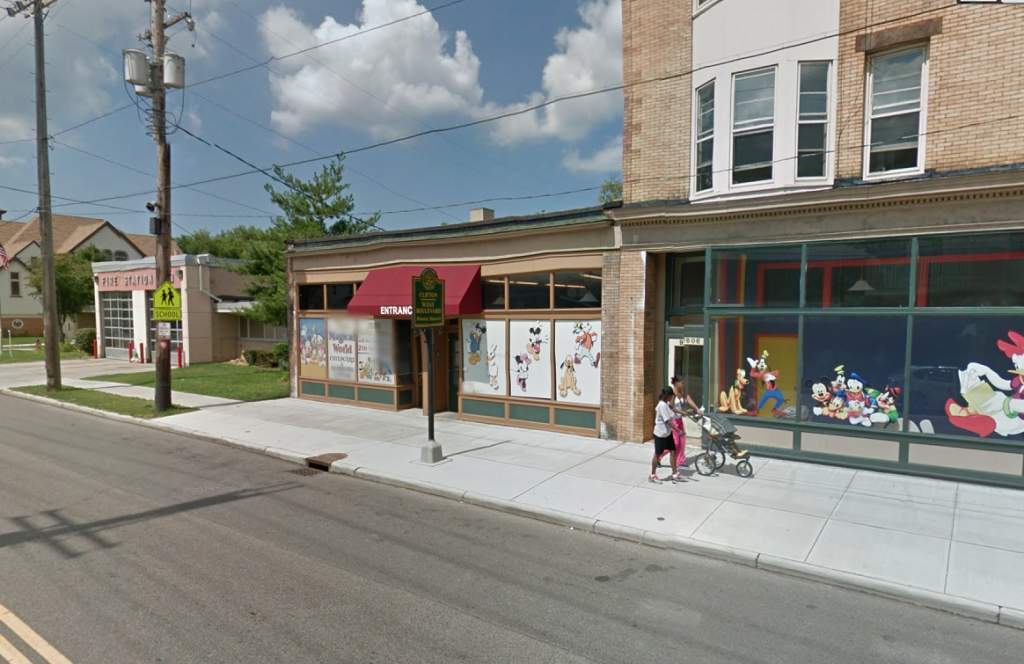 And for the other side of the street:
And for the other side of the street:
 Thus we note that where Tamir is playing is between nothing and nothing, not a cross route between anywhere people live and anywhere people go.
Thus we note that where Tamir is playing is between nothing and nothing, not a cross route between anywhere people live and anywhere people go.
Go back up to the satellite view again. Tamir is in a very secluded area, no foot traffic, no reason to visit a forlorned and forgotten recreation area where a lonely child would play out his own police drama fantasies before becoming the victim of someone else’s police drama fantasies.
Let’s be clear, Tamir had every reason to believe no one would ever see him acting like a child with a toy gun. In today’s world where he could be watching internet porn or selling drugs, Tamir was playing like a child.
What have we established here?
Most certainly that there are no issues of him having altered a toy gun to look like a real gun when nobody made any attempt in the first place.
The video isn’t a police operation at all, it looks like a gang hit. If there were people around, the police would have endangered them for sure, meaning the police knew no one was around.
That makes this murder.
If these are Cleveland police, they would have figured out quickly that their “witnesses” were fabricators right out of McKinney, Texas or Jade Helm.
Nobody saw anything. Then again, what if someone were there? Why would they be out in freezing cold, between nowhere and nowhere else, approaching a child with a toy gun? What could their reasoning be?
Shouldn’t they, if they existed, be questioned?
“Why were you in a hidden alcove at the recreation center? Where were you going? Where did you come from?”
The rest of us can see that where Tamir was playing is between nowhere and nothing, can’t be seen from a sidewalk, not from a home, not from a car, somewhere nobody who wasn’t “up to no good” had any reason to be…unless they were a 12 year old playing with a toy gun.
End of story.
Loehmann, who was a rookie at the time of the incident, along with his training officer Frank Garmback, are under a grand jury investigation, which will lead to either an indictment or dismissal of the case.
“It is simply obvious that the officers had a reasonable belief that Rice was armed.”
Katsaris has successfully testified to clear a Cleveland patrolman before. Officer Michael Brelo faced two voluntary manslaughter charges after a 2012 car chase ended with him shooting 15 rounds into two unarmed black people, killing them both. Katsaris found it was justified and the judge acquitted Brelo.
“Regrettably, with the release of yet another utterly biased and shamelessly misguided ‘expert report’ the County Prosecutor is making clear his intention to protect the police from accountability under the criminal laws, rather than diligently prosecute them,” the lead attorney in the Tamir Rice case, Jonathan Abady, said in a statement on Thursday.
“It would be premature for me to announce any final decision on charging,” Timothy McGinty, the county prosecutor, said in a statement.
McGinty has faced rising pressure to remove himself from the case since last week, when he questioned the motives of the Rice family and attorneys.
McGinty answered, “They waited until they didn’t like the reports they received. They’re very interesting people… let me just leave it at that… and they have their own economic motives.”
On Friday, local clergy gathered the press and read aloud a letter to McGinty, addressing that statement.
“Your most recent comments that the Rice’s family’s motivations are economic in nature are reprehensible and further add to the growing sentiment that the matter in which the Rice case has proceeded is tainted with bias at the worst and poorly handled at the minimum,” the letter signed by four reverends and a rabbi stated.
ATTENTION READERS
We See The World From All Sides and Want YOU To Be Fully InformedIn fact, intentional disinformation is a disgraceful scourge in media today. So to assuage any possible errant incorrect information posted herein, we strongly encourage you to seek corroboration from other non-VT sources before forming an educated opinion.
About VT - Policies & Disclosures - Comment Policy






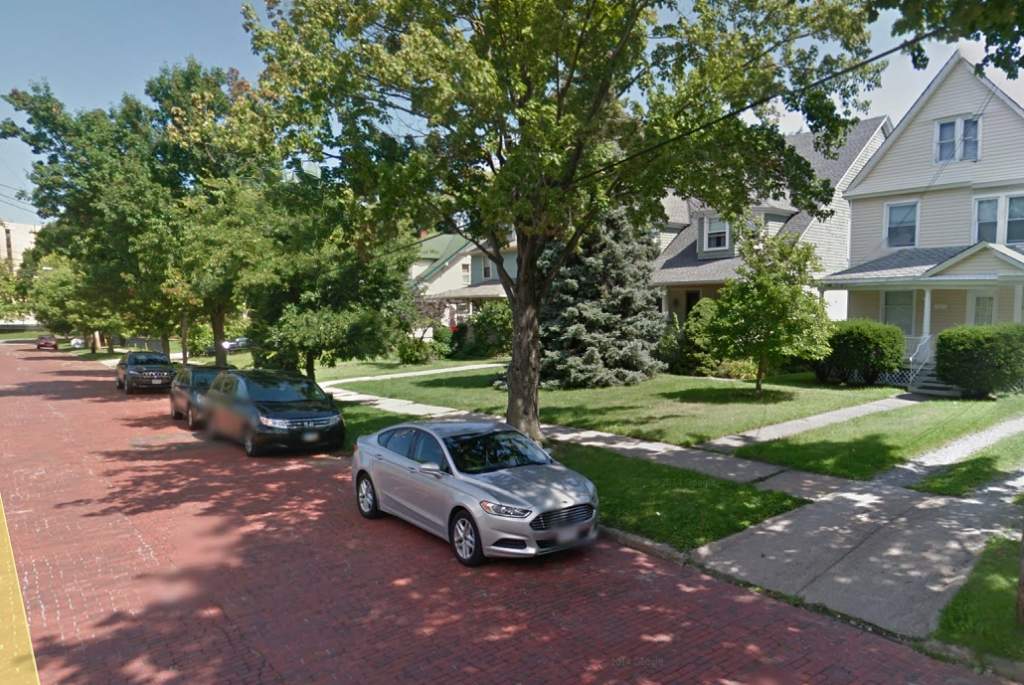




Comments are closed.